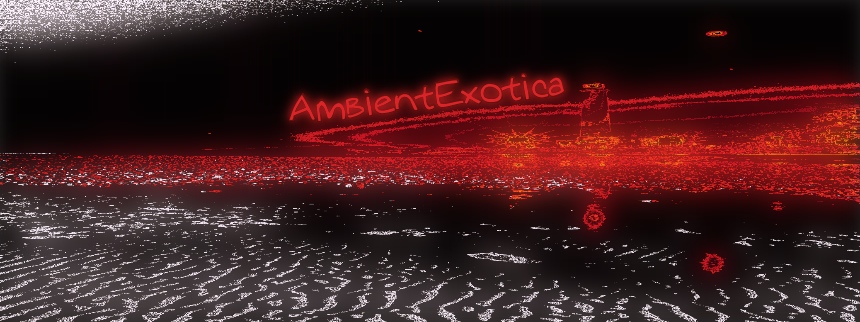
Snoqualmie Falls
Dream Sequence
2014
Everyone has a picture in mind once he is confronted with the famous Snoqualmie Falls in Washington. It so happens that this majestic outlook is sewn into the existence of the eponymous Ambient/Drone project as embodied by Hamilton, New Zealand-based Alicia Merz and West Sussex, UK-based Jeff Stonehouse. Dream Sequence is a long-form track of 60 minutes, released in June 2014 on Gavin Catling‘s Twice Removed Records from Perth, Australia, and available to purchase and stream at Bandcamp. The factory-pressed CD is housed in a stitched transparent tracing paper sleeve with a double sided card insert. Globalism and connection play a big role, and I have indeed named many a country and destination in this opening section already. There is no need to do this in the following paragraphs, as the locale of Dream Sequence cannot be shown on any map. It is a refreshingly mystical and intensive take on the omnipresent dream topos and topic, one which is based on Stonehouse’s heavily processed and hence ethereal guitar drones and Merz’s unrecognizable vocals, the latter of which cannot be deciphered, let alone distilled or recognized at all. They must be somewhere in the soundscape, but it is not clear how they unfold and show themselves. No synths are used, quite a surprising omission given that Dream Sequence is (also) a Space Ambient album, at least according to the driving force behind the frizzling airflows, silkened low frequency eruptions and opalescent diffractions. Nowhere in the press blurb is the Space Ambient genre coined, but a galaxy shimmers through the front artwork, an important hint of the things enshrined in the container, regardless of whether this refers to the physical CD or the digital-only version. The concept of space is observable throughout the runtime. However, Snoqualmie Falls’ longest piece is also home to diametrally opposite forces and contrapuntal devices. What’s even more bewildering: Merz and Stonehouse do not give in to a histrionic aural cinematography, but manage to hold these patterns together and make them appear both arcane and amicable.
The gateway to Dream Sequence offers much delight and is enormously meaningful to the connoisseur of Space Ambient in particular and heterodyned Drone dioramas in general. The slow fade-in phase with its wondrously argentine-colored cloudlets and eminently elasticized flashes of braking trains prepares the listening subject of the things to come. Admixed aerose microglitters and heating circulation-based exhalations create a fittingly oneiric diorama that is both driven by a reticulation of wideness and its very foe, namely a clandestinely restricted pressure chamber effect. Providing room by confining space, does this even make sense? Not when the laws of physics are applied, but aesthetically speaking, Dream Sequence is at its strongest when countermovements infiltrate its acatalepsy. There is that moment of (rev)elation, of theophoric incandescence that slowly trickles in around the six-minute mark and which pinpoints the delicate quandary Snoqualmie Falls’ debut is situated in: amid the abyssal two-note bass bursts which bring The Orb’s virtuous Ambient stomper O.O.B.E. (1992) to mind, there is a prolonged polar light splaying its aureoles. This towering nebula is bright and cold, whereas the underlying low frequency cannelure is dark and warm.
The very nature and artistic vision of Dream Sequence demands slow movements and mucoid formations so that the listener does not realize a new segue right from the get-go. Majestically swirling, magnanimously flittering, the basic premise never changes, even the textural range emits the self-imposed set of intrinsic rules. Only microscopic alterations are allowed to materialize in adjacency to the multiplexed chromaticity, or rather constancy. The two-note bass melody remains the reliable force, the vesiculating aorta of the long-form track, calculably pulsating for thousands of seconds. It is the heartbeat of the dreaming organism, but this is just one obvious interpretation. A deeper thought transforms this arcane leitmotif into a coxswain, a vade-mecum which encapsulates the listener’s trust to guide him or her through the thickly wadded fog banks and steamy diffusion. I have to admit that this train of thought finds a better use in reviews of self-help tapes and New Age albums, but the recurrence, the stabilized ultraviolet effulgence of these pompous bass droplets offer solace and become curiously benign and cordial as the languorous influx floats on.
This kind of flow or progression is, as stated before, cautiously camouflaged, the listener is either lost in the wideness or – given that the opposite is also the case – simultaneously paralyzed by the cramped nucleus. This bewildering concomitance is cleverly augmented by the frequency patterns. Alicia Merz and Jeff Stonehouse make sure that the surfaces and processed virtual characteristics do neither harm the proprioception nor the equipoise. Time flies, tides change, and it so happens that even the ubiquity of the vestigial bass melody comes to a halt. Once this happens, the formerly accidentally blotchy physiognomy of Dream Sequence morphs into a rectilineal 3D expansion. But most important is the sudden insight into the pulled down epithelium of guardianship. It is at this point that Snoqualmie Falls’ rufescent cauldron becomes truly spatial. This interpolation reduces the thermal heat and likewise decreases the effulgent braiding of mellow superfluids. Without the use of icicles, xylophones or music boxes, not even with the help of various Glitch ingredients such as jitters or static noise, the duo is capable to invoke an interstice which harbors Space Ambient, Dark Ambient and Hauntology in equal parts. The solution could result in teaching the transcendent bystander that nothing lasts forever, with the efflorescence of that catchy bassline being the primary piece of evidence, but in a wonderful turn of events, this is not the adage Snoqualmie Falls has in mind, for the two-note bass layer returns, and with it the dark but vigorously flickering beam of light, the constant of the universe, the torch to illumine the gigantomachy and wash away the weathering agents.
If I called Dream Sequence a streamlined effort – I am doing just that in this very parenthesis – there is that bitter aftertaste, the insinuation at best and misrepresentation at worst that Alicia Merz and Jeff Stonehouse chose the easy way out by bundling an all too narrow set of particles and policies which deny a real progression in the spirit of coruscating kaleydoscopes and technicolor zoetropes. This concentrated endeavor, however, allows something that is less saltatory and saccharified, and that is a soothingly enigmatic journey through dreams, time and space. The problem is neither found in the comparably mundane concept itself, nor the ginormous competition of similar releases, but the difficulty in transporting the skillful craftsmanship and gorgeous vortex that is Dream Sequence. It is true that as you are reading this sentence, hundreds of bedroom musicians as well as professional synth wizards from all over the globe produce Ambient albums that target the same concept of dreams and related figments or visions. Keeping this in mind, Snoqualmie Falls deliver some stupefyingly 60 minutes of stokehold steam, space scintillae and a mellowed form of iridescent Industrialism poured into a mould known as Drone. The captivating thing about Dream Sequence is that it is many things at once… a surprising and potentially contradictive conclusion given that Merz and Stonehouse chose their equipment wisely. The shadiness and crepuscular complexion make it possible to interpret the long-form piece as a synergetic alloy of many a subgenre or inferior motive. I am embracing the Space Ambient term due to the depicted markers on the front artwork, but it could be something entirely different and nonetheless familiar to other listeners. Do not wish for Space opera laser beams and frilly embellishments, as this Drone artifact is mercilessly convoluted, hued in withdrawal, keen on remoteness by letting the listener decide which kind of journey, incident or microscopic chain reaction unfolds. That's the beauty of dreams: the have many meanings; there are gleeful portent and pernicious happiness aplenty.
Further listening and reading:
- Dream Sequence can be purchased and fully streamed at Bandcamp.
- Twitter galore: @jeffstonehouse, @aliciamerz, @twiceremovedrec.
Ambient Review 346: Snoqualmie Falls – Dream Sequence (2014). Originally published on May 28, 2014 at AmbientExotica.com.
